Miss Mitsuyo Kuki
A Japanese Wagashi confectioner
|
September is here. Under the full moon, we sometimes plan a tea ceremony.
When we enjoy tea (powdered green tea), sweet things are necessary before
drinking tea. Wagashi is always used here.
This month, I would like to introduce you a girl who makes Japanese traditional
sweet, Wagashi.
She is the 4th generation of Confectionery Kaikado. Her father Akihito
Kuki was a very special Wagashi confectioner. Akihito died suddenly in
November last year. He was only 61 years old. We are sorry that we lost
a traditional professional person in this historical city.
His second daughter Mitsuyo had worked with her father for several years.
It is now her responsibility to take over Akihito's work. Mitsuyo is 31
years old, still young and premature as a traditional confectioner. But
with her mother Kyoko and her sisters' help, Mitsuyo is getting along very
well.
Before introducing Mitsuyo, I will show you some explanation of Wagashi
from Wikipedia.
Wagashi (和菓子)
is a traditional Japanese confectionery which is often
served with tea, especially the types made of mochi, azuki bean paste, and
fruits.
Wagashi is typically made from natural (mainly plant) ingredients. The names
used for wagashi commonly fit a formula—a natural beauty and a word from
ancient literature; they are thus often written with hyōgaiji (kanji that are not commonly used or
known), and are glossed with furigana.
Generally, confections that were introduced from the West after the Meiji Restoration
(1868) are not considered wagashi. Most sorts of Okinawan confectionery and those
originating in Europe or China that use ingredients alien to traditional
Japanese cuisine, e.g., kasutera, are only rarely referred to as
wagashi. Most wagashi are made entirely of plant-based ingredients.
Well, you know what is Wagashi now, so please see the photos.
|
|
|
On Akihito's 60th birthday
From the left: Reiko, eldest daughter, Eiko, third daughter, Akihito with
roses, Mitsuyo with a new pair of festival Zori (shoes) as a gift. Akihito
loved Karatsu Kunchi Festival, and served for long as a leader of the group
of the 8th Float, the Gold Lion. |
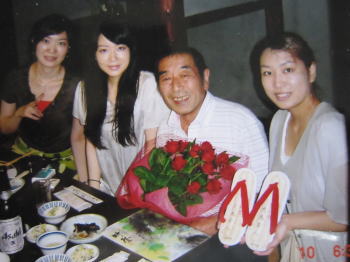 |
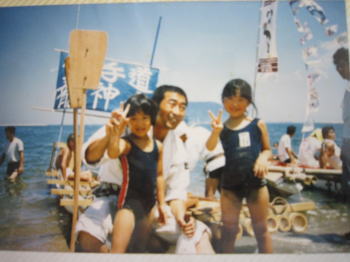 |
Akihito loved the sea of Karatsu. He was the leader of the group which
hosted "The Raft Race" on the beach near his house.
Mitsuyo 5 years old, Reiko, 6. |
In front of the festival float.
Mitsuyo (left) 8 years old |
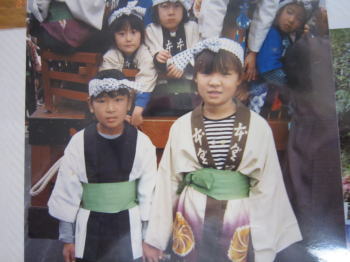 |
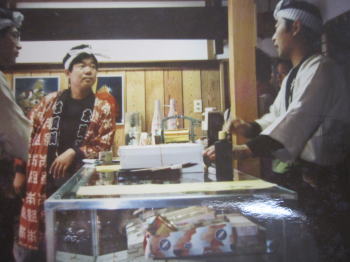 |
Akihito, still young, talking with the festival group. |
| At highschool, Mitsuyo was a smart student. She went to Aomori Prefecture
to attend the Agricultural Students' Forum as a representative of all Kyushu
students. |
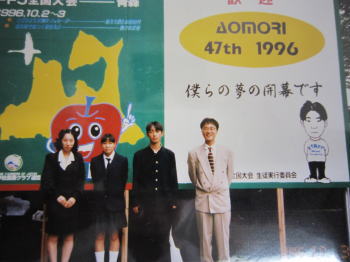 |
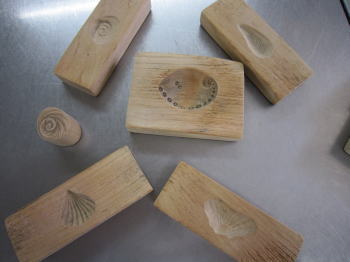 |
With these wooden molds, Mitsuyo makes the sweet sugar candy of which
photo you will see above. |
| Mitsuyo, working in her studio. |
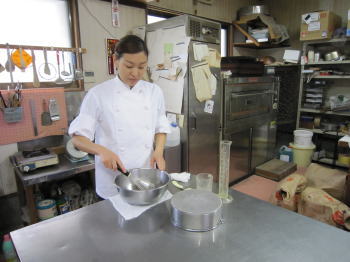 |
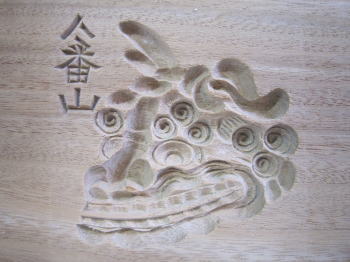 |
Another mold for another type of sweet. This design is the 8th Float, Gold
Lion of Honmachi Street of Karatsu City. |
| 20 years ago, a newspaper wrote this article about Akihito's shop. |
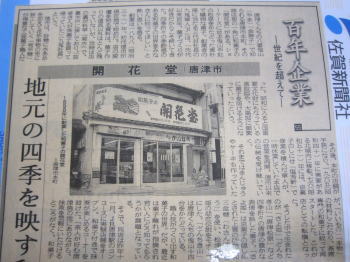 |
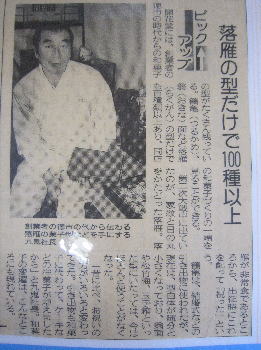 |
Akihito's elaborate work was introduced in detail in this article, too. |
| Mitsuyo at present. |
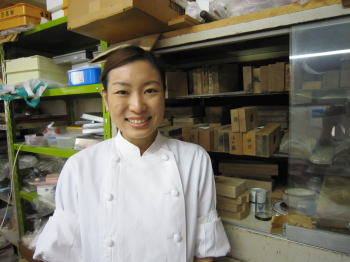 |
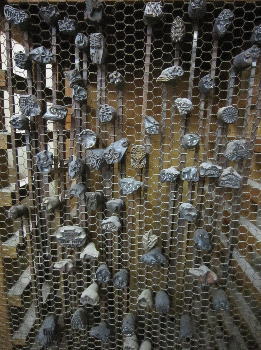 |
Small branding irons with a variety of design of all seasons.
Wagashi needs a sense of season, occasion, or purpose.
These designs of seasonal flowers, small animals, or abstract designs of water, cloud, etc, make the usual Wagashi become special things matching with the purpose of the tea ceremony. |
This August was Hatsubon, the first Obon festival, for Akihito. On the last day of Hatsubon, a
boat was prepared on which the spirit of the deceased person goes back
to the other world. On this boat, family put things which the late person
loved much. This boat was set sail on the sea at night of August 15.
For Akihito, a paper miniature of the Gold Lion, and paper dolls of the
float pulling people. |
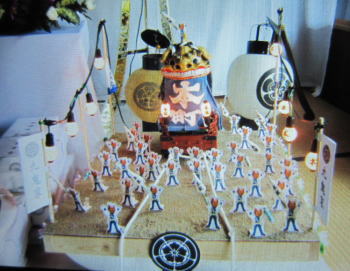 |
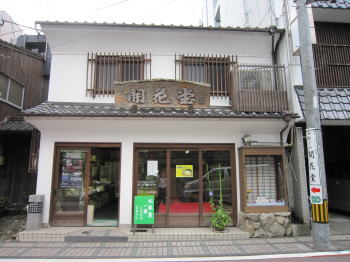 |
This is the main shop of Kaikado. Here you can enjoy a bowl of green tea
with a sweet. |
Mitsuyo's big sister Reiko came back to help Mother and Mitsuyo after Father's
death.
|
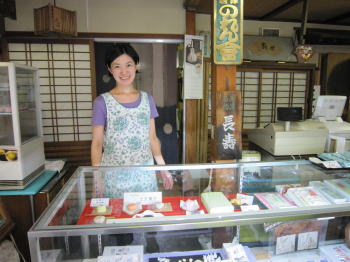 |
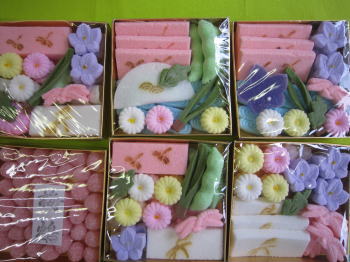 |
Mitsuyo makes these traditional sweets cold Higashi using the molds which her great grandfather made and her father cherished. |
| Lord Ogasawara wrote a poem on one of the renowned Wagashi of Kaikado more
than 50 years ago. |
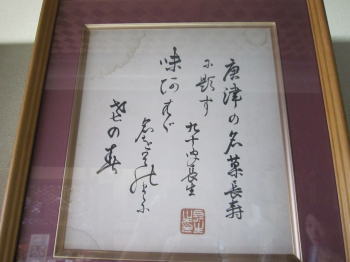 |
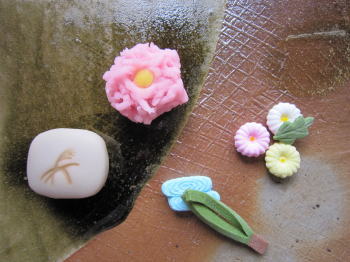 |
Pretty, aren't they?
Pink chrysanthemum, and small chrysanthemums, white rice cake with the
print of autumn pampas grass, water and pine leaves. |
|
|
|
Kaikado was founded about 110 years ago. Mitsuyo's dream is to make Kaikado
last for another hundred years.
Karatsu is an old Castle town. Such town needs such old, traditional type of shops. I hope Mitsuyo's wish will come true.
Thank you very much, readers, I will see you again next month.
|
|
|
|